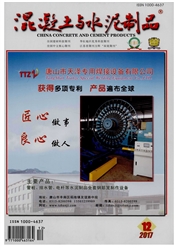

 中文摘要:
中文摘要:
采用150g/L的硫酸钠溶液半浸泡的试验方法,以砂浆抗蚀系数为指标,研究了相对湿度和温度变化条件下,硫酸钠溶液的不同结晶产物Na2SO4(无水芒硝)与Na2SO4·10H2O(芒硝)对砂浆试件的物理侵蚀作用和不同条件下硫酸钠溶液的物理侵蚀特性及相关机理。结果表明:与环境温度变化条件相比,硫酸钠溶液在相对湿度变化条件下对砂浆试件造成物理侵蚀作用更为严重,这主要是在相对湿度变化条件下,硫酸钠溶液的结晶产物Na2SO4与Na2SO4·10H2O发生相互转化造成的。硫酸钠溶液形成Na2SO4结晶产物时,其对砂浆造成的物理侵蚀破坏作用较形成的Na2SO4·10H2O结晶产物更为显著。
 英文摘要:
英文摘要:
In order to investigate the physical attack of different crystal products of sodium sulfate solution including Na2SO4 (thenardite) and Na2SO4·10H2O(mirabilite) on cement mortar under different relative humidity and temperature conditions, experiments were carried out by partial soaking with 150 g/L sodium sulfate solution and an index was introduced to evaluate the resistance of mortar to physical attack of sodium sulfate solution. The characteristics of the physical attack of sodium sulfate solution under different conditions and corresponding mechanisms were further discussed. The results indicate that physical attack caused by the change of relative humidity is more serious than that of caused by temperature change because transformation between Na2SO4 crystal and Na2SO4·10H2O crystal takes place when the relative humidity changes. Compared with Na2SO4·10H2O crystal, the formation of Na2SO4 crystal from sodium sulfate solution results in more serious destruction of mortar.
 同期刊论文项目
同期刊论文项目
 同项目期刊论文
同项目期刊论文
 期刊信息
期刊信息
